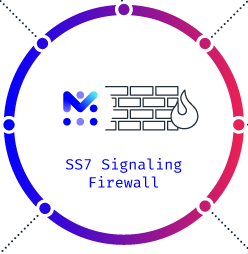An SS7 firewall is a network security device that is designed to protect SS7 networks from various security threats, such as hacking, fraud, and other unauthorized access attempts. The firewall is designed to analyze the signaling messages that are transmitted across the SS7 network and to filter out any messages that are considered suspicious or potentially harmful.
An SS7 firewall typically operates at the network edge, where it can intercept signaling messages and analyze them in real-time. The firewall can use various techniques to detect and block malicious messages, including signature-based detection, behavior-based detection, and anomaly detection. The firewall can also apply access control policies to prevent unauthorized access to the SS7 network.
In addition to providing security protection, an SS7 firewall can also provide visibility and control over SS7 traffic. The firewall can generate reports on SS7 traffic patterns and usage, and it can provide administrators with real-time alerts on suspicious activity.
SS7 firewalls are typically implemented as hardware devices that sit at the edge of the SS7 network. They may also be implemented as virtual appliances or software-based solutions that run on servers or other network devices. The firewall may be integrated with other security technologies, such as intrusion detection and prevention systems (IDPS), to provide comprehensive protection against a wide range of security threats.
One of the primary functions of an SS7 firewall is to prevent unauthorized access to the SS7 network. This can be done by enforcing access control policies that limit the types of signaling messages that are allowed to enter or leave the network. The firewall may also use techniques such as packet filtering and deep packet inspection to analyze incoming and outgoing traffic and block any messages that are considered suspicious or potentially harmful.
Another important function of an SS7 firewall is to provide visibility and control over SS7 traffic. This can be done by generating reports on SS7 traffic patterns and usage, and by providing administrators with real-time alerts on suspicious activity. The firewall may also be configured to allow network operators to monitor and analyze SS7 traffic in order to optimize network performance and improve quality of service.
One challenge with SS7 firewalls is that the SS7 protocol is complex and can be difficult to analyze and interpret. As a result, SS7 firewalls must be designed to handle a wide variety of signaling messages and to detect and block messages that are anomalous or suspicious. They must also be updated frequently to keep up with evolving security threats and new attack techniques.
SS7 firewalls may use a variety of techniques to detect and prevent security threats. One technique is to use signature-based detection, where the firewall compares incoming and outgoing signaling messages to a database of known attack signatures. If a message matches a known signature, the firewall can take appropriate action, such as blocking the message or alerting network administrators.
Another technique used by SS7 firewalls is behavior-based detection. This involves analyzing the behavior of signaling messages and identifying patterns that are consistent with attacks or other malicious activity. For example, if a message is attempting to modify a call forwarding setting for a large number of subscribers in a short period of time, this could be indicative of a fraud attack. The firewall can then take action to block the message and alert administrators.
An SS7 firewall may also use anomaly detection techniques, which involve comparing current traffic patterns to historical patterns and looking for deviations. This can help identify unexpected or suspicious behavior that may be indicative of an attack or other security threat.
In addition to protecting against security threats, SS7 firewalls may also be used to enforce regulatory compliance. For example, they can be used to ensure that network operators are complying with regulations around call setup and billing.
SS7 firewalls may also be used to provide network segmentation and isolation. This can be important in cases where different network elements are used by different operators or service providers. By segmenting the network and controlling access to different parts of the network, SS7 firewalls can help ensure that each operator or service provider can only access the network elements they are authorized to use.
Conclusion
An SS7 firewall is an essential security measure for protecting SS7 networks from various security threats. It is important to implement effective security measures to ensure the integrity and availability of these networks, which are critical components of the global telecommunications infrastructure.
SS7 firewall is an important security measure for protecting SS7 networks from various security threats. As the SS7 protocol is a critical component of the global telecommunications infrastructure, it is essential to implement effective security measures to ensure the integrity and availability of these networks.
